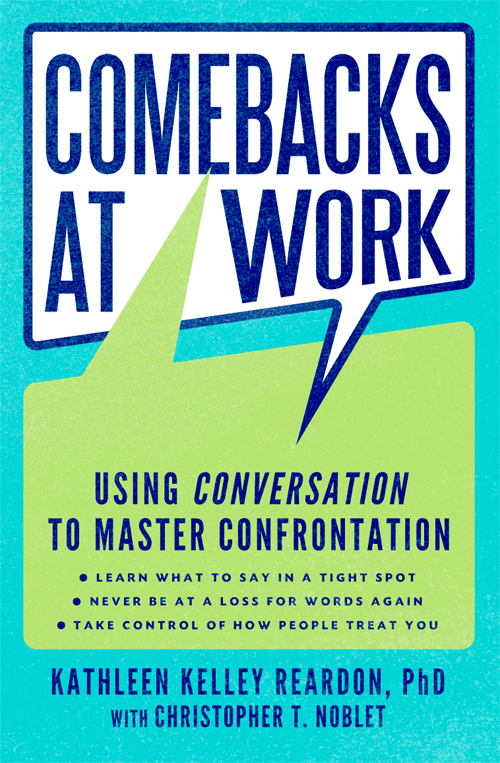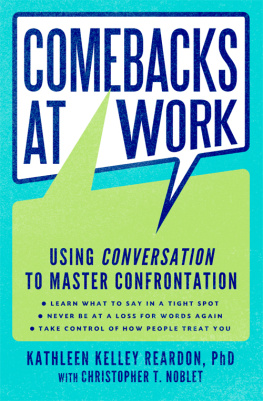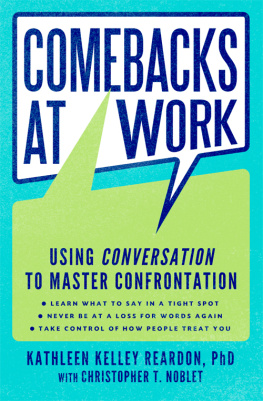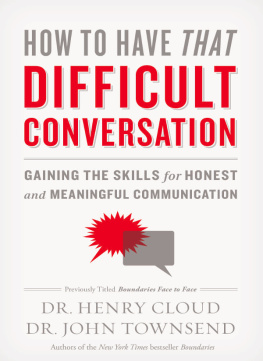Kathleen Kelley Reardon - Comebacks at Work: Using Conversation to Master Confrontation
Here you can read online Kathleen Kelley Reardon - Comebacks at Work: Using Conversation to Master Confrontation full text of the book (entire story) in english for free. Download pdf and epub, get meaning, cover and reviews about this ebook. year: 2010, publisher: HarperBusiness, genre: Religion. Description of the work, (preface) as well as reviews are available. Best literature library LitArk.com created for fans of good reading and offers a wide selection of genres:
Romance novel
Science fiction
Adventure
Detective
Science
History
Home and family
Prose
Art
Politics
Computer
Non-fiction
Religion
Business
Children
Humor
Choose a favorite category and find really read worthwhile books. Enjoy immersion in the world of imagination, feel the emotions of the characters or learn something new for yourself, make an fascinating discovery.
- Book:Comebacks at Work: Using Conversation to Master Confrontation
- Author:
- Publisher:HarperBusiness
- Genre:
- Year:2010
- Rating:4 / 5
- Favourites:Add to favourites
- Your mark:
- 80
- 1
- 2
- 3
- 4
- 5
Comebacks at Work: Using Conversation to Master Confrontation: summary, description and annotation
We offer to read an annotation, description, summary or preface (depends on what the author of the book "Comebacks at Work: Using Conversation to Master Confrontation" wrote himself). If you haven't found the necessary information about the book — write in the comments, we will try to find it.
Comebacks at Work: Using Conversation to Master Confrontation — read online for free the complete book (whole text) full work
Below is the text of the book, divided by pages. System saving the place of the last page read, allows you to conveniently read the book "Comebacks at Work: Using Conversation to Master Confrontation" online for free, without having to search again every time where you left off. Put a bookmark, and you can go to the page where you finished reading at any time.
Font size:
Interval:
Bookmark:

Comebacks at Work
Using Conversation to Master Confrontation
Kathleen Kelley Reardon, Ph.D.,
with Christopher T. Noblet, M.B.A.

The dearest of friends, Ellen Van Horne Nichols
Contents
Introduction
The Art of the Comeback
N o doubt youve been put on the spot or cornered in conversation. We all have. Maybe it happened in a discussion you had last week or even yesterday. Perhaps, embarrassed in public, your response just wasnt good enough. You felt somehow inadequate, and angry. You wasted hoursmaybe even daysdwelling on the event and rolling it over and over in your mind. You castigated yourself with each and every replay and perhaps ended up hating the person or people whom you held responsible for your disgrace. Then, suddenly in the midst of your unrelenting misery, it came to you. I should have said... But its too late now. All you can do is wonder: Why didnt I think of that then?
The answer is simple. If you find yourself in this kind of situation often, you didnt think of saying the effective thing because you havent yet mastered the art of the comeback. Youre not alone. And the good news is that this condition is only temporary.
No one is born a comeback expert. It takes trial and error, adherence to a set of principles about communication, and practice with an array of options. What it doesnt require is that you be someone other than yourselfjust a more astute version. And dont expect to turn into a communication pro overnight. The most expert among us, even those people who seem to know what to say under any and all circumstances, still have their If only Id said moments.
WHAT THIS BOOK WILL DO FOR YOU
The goal of this book is to render those situations rare for you. While its useful to have a list of quips ready to use when youre in a tight spot (and youll find some of those here), learning to distinguish between types of situations is important, too. When, for example, should you give back as good as you got? When should you cut someone some slack? And what are all the stages in between? Essentially, youll learn how to handle a variety of situations and, in so doing, avoid reliving them in the future.
Well begin by looking at what comebacks are, and at the typical obstacles that stand in the way of people dealing with them effectively. Were all responsible for how others treat us because were part of any communication with them. If we commonly let insults pass that should be addressed, we are telling other people that they can walk all over us with impunity. Thats not good. So in this book we advance, early on, the perspective that what happens to us at work is usually due to what we allow or disallow.
Since all of us are creatures of habit, the way we communicate often becomes unsurprising, and this in itself can get us into trouble. If you are completely predictable at work, anyone can manage you, whether a boss, a colleague, or someone who works for you. We tackle that problem in the first four chapters of this book. You need to get in charge of what happens to you at work, and that includes not allowing people to know how they can anger, hurt, bully, dupe, or in some other way maneuver you to their liking.
Chapter 5 looks at why so many of us draw a mental blank when we run into situations that call for comebacks. Why do we freeze up? What is it that allows ushours laterto think of what we should have said but didnt when the time was right? Well show you how you can get rid of that tendency and free yourself to consider a host of comeback options.
A good part of being able to identify and employ comebacks with comfort is having a set of them available to you. So, even if you already have some of your own, we introduce in chapter 6 the R-List: a set of ten types of comebacks that you can begin to experiment with today. Among these strategies, youll learn to reframe, restate, and retaliate, and you can keep all ten techniques in mind or in your desk for those times when you need help.
In chapter 7 we look at the role that gut instinct plays in comebacks. We all have gut instincts, but we dont always trust themsometimes with good reason. How can you nurture your own instinct to a point where youll feel sufficiently confident to let it help you choose and execute good comebacks? To assist you with this, we will introduce a way of looking at the rational and gut aspects of every comeback decision and of determining whether one or the other will likely bring about the best results. Additionally, the most effective comebacks are not without passion, so well also explore in this chapter how emotions and body language contribute to the skilled comeback equation.
In chapter 8 well focus on how to use comebacks when conflict is inevitable, and well especially look at how to avoid making a situation personal that doesnt need to be. In other words, well explore when to insert ourselves into a comeback and when to be objective. This will continue to develop your ability to select better comebacks.
There is, however, no such thing as a comeback that, no matter how clever, works with all people and in all settings. That is why the next two chapters are about how to read conversation partners and situations. Chapter 9 will teach you how to take peoples pulse, so to speak, and to determine which types of comebacks are likely to work with them. We then explore in chapter 10 how situations dictate parameters that make some types of comebacks too risky and others more likely to succeed.
Establishing your comfort zone comes next. Youll learn to develop a host of comebacks and have them ready to use. These will be ones that are your own and that you know you can use because they fit who you are. Along with those, youll have a set of comebacks that take you outside your comfort zone for those times when someones rudeness or crudeness exceeds your threshold.
Along the way, the chapters include methods of testing yourself and organizing what is introduced in each chapter, while chapter 11 introduces a self-assessment technique that will help you condense what you have learned in a way that facilitates recollection when you need to use comebacks in the future. By asking yourself the ten questions featured in the final chapter, you will be better prepared to use more effective comebacks the next time youre put on the spot.
Ive spent my career teaching and training people to communicate more effectively. By providing a range of possibilities for a variety of situations, I will draw upon that experience to help you locate what works best for you. Together, well look also at using comebacks effectively in situations outside of the workplace, because to become proficient at comebacks, its important to know how to employ them effectively in a variety of contexts. Occasionally, too, well look at how comebacks are used in politics, or when negotiating an important purchase, or even when dealing with annoying behaviors of friends or neighbors. Youll find that these examples can be applied to work as well. By the end of the book, as if you and I had had several private sessions together, youll be on your way to mastering confrontation and taking control of how people treat you, and youll be much more in charge of what happens to you at work than ever before.
Chapter One
Why Communication Matters
B efore moving on to look specifically at comebacks, itll be useful to take a few minutes to talk about how communication works and why it matters. That is the foundation for all that follows, and the best place to start is in our brains, where the thoughts we communicate, poorly or well, originate.
Font size:
Interval:
Bookmark:
Similar books «Comebacks at Work: Using Conversation to Master Confrontation»
Look at similar books to Comebacks at Work: Using Conversation to Master Confrontation. We have selected literature similar in name and meaning in the hope of providing readers with more options to find new, interesting, not yet read works.
Discussion, reviews of the book Comebacks at Work: Using Conversation to Master Confrontation and just readers' own opinions. Leave your comments, write what you think about the work, its meaning or the main characters. Specify what exactly you liked and what you didn't like, and why you think so.











